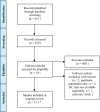Hinge/floating craniotomy as an alternative technique for cerebral decompression: a scoping review
- PMID: 31712994
- PMCID: PMC7680327
- DOI: 10.1007/s10143-019-01180-7
Hinge/floating craniotomy as an alternative technique for cerebral decompression: a scoping review
Abstract
Hinge craniotomy (HC) is a technique that allows for a degree of decompression whilst retaining the bone flap in situ, in a 'floating' or 'hinged' fashion. This provides expansion potential for ensuing cerebral oedema whilst obviating the need for cranioplasty in the future. The exact indications, technique and outcomes of this procedure have yet to be determined, but it is likely that HC provides an alternative technique to decompressive craniectomy (DC) in certain contexts. The primary objective was to collate and describe the current evidence base for HC, including perioperative parameters, functional outcomes and complications. The secondary objective was to identify current nomenclature, operative technique and operative decision-making. A scoping review was performed in accordance with the PRISMA-ScR Checklist. Fifteen studies totalling 283 patients (mean age 45.1 and M:F 199:46) were included. There were 12 different terms for HC. The survival rate of the cohort was 74.6% (n = 211). Nine patients (3.2%) required subsequent formal DC. Six studies compared HC to DC following traumatic brain injury (TBI) and stroke, finding at least equivalent control of intracranial pressure (ICP). These studies also reported reduced rates of complications, including infection, in HC compared to DC. We have described the current evidence base of HC. There is no evidence of substantially worse outcomes compared to DC, although no randomised trials were identified. Eventually, a randomised trial will be useful to determine if HC should be offered as first-line treatment when indicated.
Keywords: Decompressive craniectomy; Neurosurgery; Stroke; Traumatic brain injury.
Conflict of interest statement
Franco Servadei has received personal fees from Takeda Pharmaceutical Company, grants and personal fees from Integra LifeSciences and grants and personal fees from Finceramica SpA. The rest of the authors declare that they have no conflict of interest related to this manuscript.
Figures
References
-
- Dewan, M. C. et al. (2018) Estimating the global incidence of traumatic brain injury. J Neurosurg 1–18. 10.3171/2017.10.jns17352 - PubMed
Publication types
MeSH terms
Grants and funding
LinkOut - more resources
Full Text Sources
Medical



